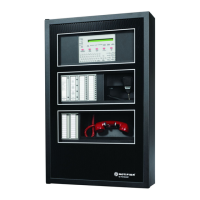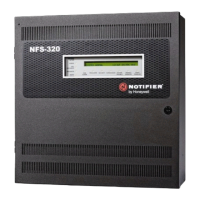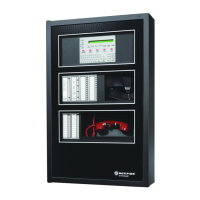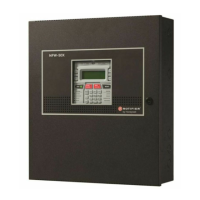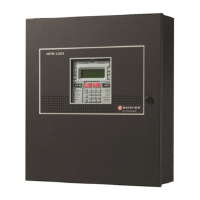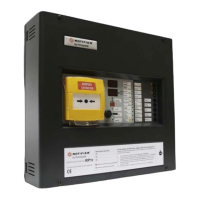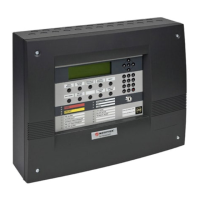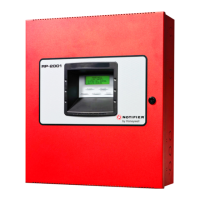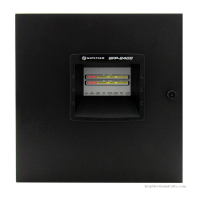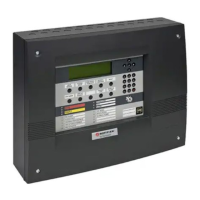NFS2-3030 Listing Document — P/N LS10006-051NF-E:F2 5/19/2022 65
5.2 Periodic Testing and Service
Periodic testing and servicing of the control panel, all initiating and notification devices, and any other associated equipment is essential to ensure
proper and reliable operation. Test and service the control panel according to the schedules and procedures outlined in the following documents:
• NFPA Standard 72’s section on Inspection, Testing and Maintenance.
• All test and maintenance instruction codes and software necessary to provide test and inspection requirements of CAN/ULC-S536, Standard for
the Inspection and Testing of Fire Alarm Systems.
• Service manuals and instructions for the peripheral devices installed in the system. Correct any trouble condition or malfunction immediately.
• Drill (Alarm Signal On for Canadian applications) - Use the Drill/Alarm Signal On key to manually activate all silenceable outputs and NACs.
Press and hold the Drill/Alarm Signal On key for 2 seconds. During a drill/alarm signal On, the panel will turn on all silenceable NACs, Turn off
the Signals Silenced LED, and sends a Manual Evacuate message to the History Buffer and installed printers, CRT-2 terminals and annunciators.
• Lamp Test - Use the Lamp Test key to test the control panel LEDs and panel sounder. Press and hold the key. The panel will light all control panel
LEDs, turn on the panel sounder, and light all segments of the LCD display. If the Lamp Test key is held longer than 5 seconds, the LCD will
display the software revisions.
5.3 Operational Checks
Before proceeding: a) notify the fire department and the central alarm receiving station if transmitting alarm conditions; b) notify facility personnel of
the test so that alarm sounding devices are disregarded during the test period; and c) when necessary, disable activation of alarm notification appli-
ances and speakers to prevent their sounding.
• Disconnect all releasing devices to prevent accidental activation in accordance with NFPA 2001, NFPA12, and NFPA 12A releasing agents.
• Check that the green POWER LED lights.
• Check that all status LEDs are off.
• Press and hold the LAMP TEST key. Verify that all LEDs and all LCD display segments work.
• Activate an Initiating Device Circuit using an alarm initiating device or an addressable initiating device on the SLC and check that all
programmed active notification appliances function. Reset the alarm initiating device, the control panel, and any other associated equipment. In
voice alarm applications, confirm that the proper tone(s) and/or messages sound during alarm conditions. Select the paging function and confirm
that the message can be heard in the affected fire zones. Repeat the above step with each Initiating Device Circuit and each addressable device.
• On systems equipped with a fire fighter’s telephone circuit, make a call from a telephone circuit and confirm a ring tone. Answer the call and
confirm communication with the incoming caller. End the call and repeat for each telephone circuit in the system.
• Remove AC power, activate an Initiating Device Circuit through an alarm initiating device or an addressable initiating device on the SLC, and
check that programmed active notification appliances sound, and alarm indicators illuminate. Measure the battery voltage with notification
appliances active. Replace any battery with a terminal voltage less than 21.6 VDC and reapply AC Power.
• Return all circuits to their pretest condition.
• Check that all status LEDs are off and the green POWER LED is on.
• Notify fire, central station and/or building personnel when you finish testing the system.
5.4 Walk Test
Walk Test allows the user to test the entire fire alarm system while away from the control panel. There are two types of Walk Test - Basic and
Advanced - and each type operates in audible mode.
Walk Test results are sent to the printer and to Event History as “Test”. In Network applications, specific nodes can be excluded from having the ability
to force the fire panel out of Walk Test. This is programmable via VeriFire Tools. Refer to the VeriFire Tools help file.
• Prior to Walk Test, secure all protected buildings, and notify the building owner/operator, fire department, and other pertinent personnel that
testing is in progress.
• Immediately after Walk Test is completed, notify the same people that testing is complete and the system is restored to normal operation.
Reconnect releasing devices.
• Walk Test will “time out” and return to normal operation after one hour when no Walk Test activations have occurred during that time.
• Walk Test may be exited at any time by pressing the ABORT soft key on the screen.
WARNING: PHYSICALLY DISCONNECT RELEASING DEVICES
DO NOT RELY ON DISABLE/ENABLE SOFTWARE SETTINGS TO LOCKOUT RELEASING DEVICES.
NOTE: The battery test requires fully charged batteries. If batteries are new or discharged due to a recent power outage, allow the batteries to
charge for 48 hours before testing.
WARNING: PHYSICALLY DISCONNECT RELEASING DEVICES
DO NOT RELY ON DISABLE/ENABLE SOFTWARE SETTINGS TO LOCKOUT RELEASING DEVICES.
WARNING: NO FIRE PROTECTION
WALK TEST MODE CAN DEACTIVATE FIRE PROTECTION. OBSERVE THE FOLLOWING IMPORTANT PRECAUTIONS.
NOTE: Walk Test will not start if any devices are active (i.e., fire alarms, security, supervisories or pre-alarms). To perform a walk test while a
device is active, disable the device and press the System Reset button.
In network applications, specific nodes can be excluded from having the ability to force the fire panel out of Walk Test due to an alarm condition.
This is programmable via VeriFire Tools. Refer to the VeriFire Tools help file.
During local or network Walk Test, activating a Mass Notification device will activate associated special function zones according to CBE
programming and simulate a Mass Notification event. Any network nodes, zones, or devices not participating in Walk Test will not participate in the
simulated Mass Notification event.
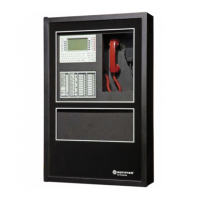
